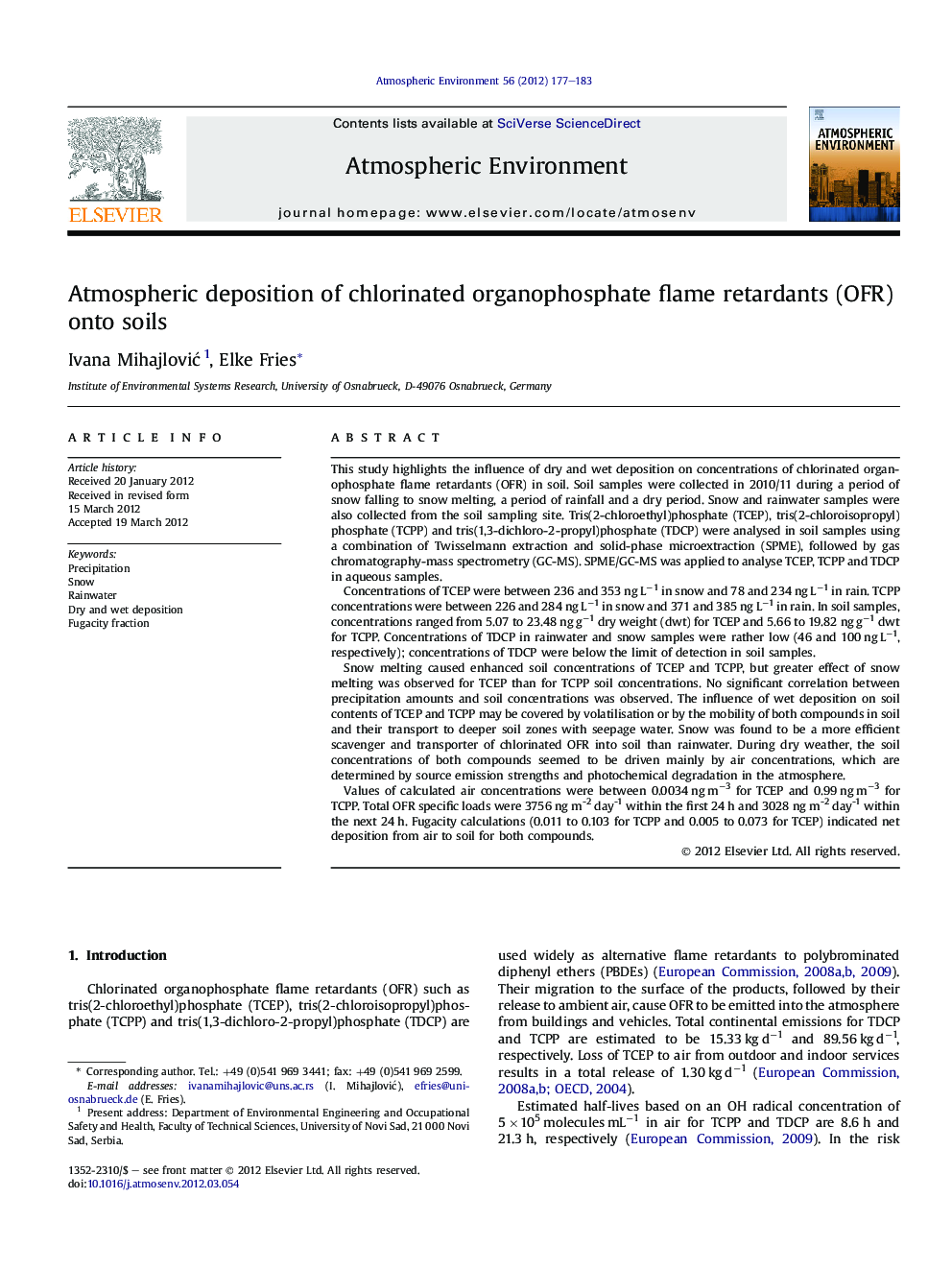| کد مقاله | کد نشریه | سال انتشار | مقاله انگلیسی | نسخه تمام متن |
|---|---|---|---|---|
| 4438729 | 1620415 | 2012 | 7 صفحه PDF | دانلود رایگان |

This study highlights the influence of dry and wet deposition on concentrations of chlorinated organophosphate flame retardants (OFR) in soil. Soil samples were collected in 2010/11 during a period of snow falling to snow melting, a period of rainfall and a dry period. Snow and rainwater samples were also collected from the soil sampling site. Tris(2-chloroethyl)phosphate (TCEP), tris(2-chloroisopropyl)phosphate (TCPP) and tris(1,3-dichloro-2-propyl)phosphate (TDCP) were analysed in soil samples using a combination of Twisselmann extraction and solid-phase microextraction (SPME), followed by gas chromatography-mass spectrometry (GC-MS). SPME/GC-MS was applied to analyse TCEP, TCPP and TDCP in aqueous samples.Concentrations of TCEP were between 236 and 353 ng L−1 in snow and 78 and 234 ng L−1 in rain. TCPP concentrations were between 226 and 284 ng L−1 in snow and 371 and 385 ng L−1 in rain. In soil samples, concentrations ranged from 5.07 to 23.48 ng g−1 dry weight (dwt) for TCEP and 5.66 to 19.82 ng g−1 dwt for TCPP. Concentrations of TDCP in rainwater and snow samples were rather low (46 and 100 ng L−1, respectively); concentrations of TDCP were below the limit of detection in soil samples.Snow melting caused enhanced soil concentrations of TCEP and TCPP, but greater effect of snow melting was observed for TCEP than for TCPP soil concentrations. No significant correlation between precipitation amounts and soil concentrations was observed. The influence of wet deposition on soil contents of TCEP and TCPP may be covered by volatilisation or by the mobility of both compounds in soil and their transport to deeper soil zones with seepage water. Snow was found to be a more efficient scavenger and transporter of chlorinated OFR into soil than rainwater. During dry weather, the soil concentrations of both compounds seemed to be driven mainly by air concentrations, which are determined by source emission strengths and photochemical degradation in the atmosphere.Values of calculated air concentrations were between 0.0034 ng m−3 for TCEP and 0.99 ng m−3 for TCPP. Total OFR specific loads were 3756 ng m-2 day-1 within the first 24 h and 3028 ng m-2 day-1 within the next 24 h. Fugacity calculations (0.011 to 0.103 for TCPP and 0.005 to 0.073 for TCEP) indicated net deposition from air to soil for both compounds.
► Chlorinated OFR e.g. TCEP and TCPP were detected in snow, rainwater and soil samples.
► No significant correlation between precipitation amounts and soil concentrations was observed.
► Air concentrations were calculated from rainwater concentrations.
► Fugacity calculations indicated net deposition from air to soil for both chlorinated OFR.
Journal: Atmospheric Environment - Volume 56, September 2012, Pages 177–183